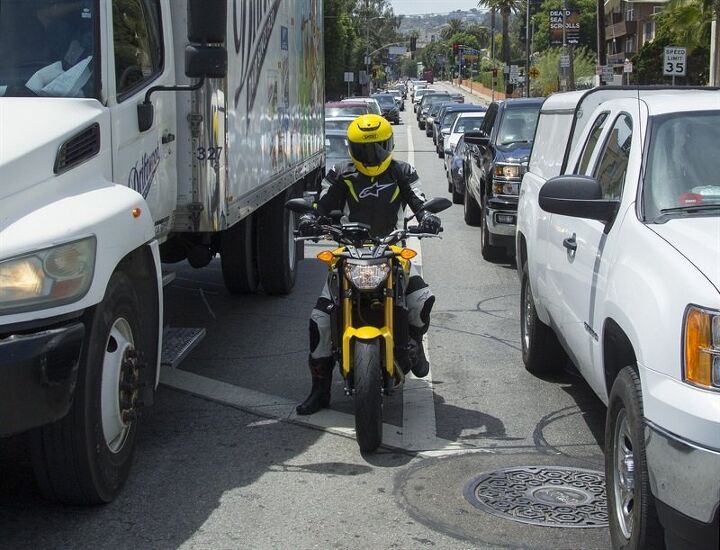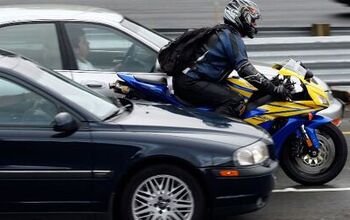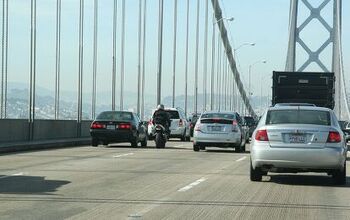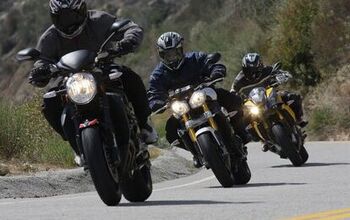Is Lane Splitting Legal? Where?

That depends where you're located
In crowded metropolises around the world, two-wheeled motorists flow through city streets packed to the brim with four-wheeled unfortunates impatiently waiting as traffic slows to a crawl en route to their destination. For those who haven’t come to terms with spending hours on end in their cages only to cover meager distances, traffic can be an incredibly frustrating experience. I’m getting myself worked up about it just typing this!
How can you free yourself from this life-draining monotony? Take it from us, the answer to what ails ya is almost always: buy a motorcycle (or scooter)! Then you can filter, lane share, or lane split your way to your destination in style and on time.
Oh yeah, but if you’re in the U.S. of A., you might also have to move. Lane sharing Stateside isn’t as prevalent in our vast country as it is in much of the rest of the world. There are a handful of states with pending legislation and Utah, Hawaii, and Montana have adopted forms of lane splitting, but California continues to be the only state where lane splitting is widely practiced.
Let’s take a closer look at the ins and outs of what it is and where it’s legal.
What is lane splitting?
Or lane sharing, or filtering? The terms are often used interchangeably so we’ll just use lane splitting from here on out. Lane splitting is, as stated in California’s AB 51: “driving a motorcycle, as defined in Section 400, that has two wheels in contact with the ground, between rows of stopped or moving vehicles in the same lane, including on both divided and undivided streets, roads, or highways.” As mentioned before, guidelines or rules around these practices change in the few states that allow the maneuver, which we’ll get into below.
Is lane splitting safe?
In many ways, lane splitting can be a safe alternative to sitting in traffic, conversely, if a rider is not aware enough of his or her surroundings, it can also be dangerous. Like every aspect of safely riding a motorcycle, vigilance is key.
While lane splitting, riders should always watch out for – and try to predict – what drivers may be about to do around you. Keeping your speed in check helps you to have the time to brake or maneuver around unexpected situations. Most scenarios that could cause harm to motorcyclists while lane splitting are going to come from in front or the side, so again, keeping the differential in speed low is paramount to ensuring you, as the rider, have time to react.
Motorcyclists who are lane splitting are less likely to get rear ended by inattentive drivers. There typically aren’t vehicles directly behind riders, and usually while lane splitting, the motorcyclist is going slightly faster than traffic around them. That said, it’s best to operate as though no one has seen you, is looking out for you, or knows that you may be passing them. Expect the unexpected.
One of the most important aspects to staying safe on a motorcycle is situational awareness. You must be paying attention to everything going on around you, including what the motorcycle is doing beneath you. Keep your head on a swivel, as they say. When lane splitting, this is all amplified as the tolerances between the rider and other cars are decreased.
Lane splitting in California
Slicin’ through traffic in the Golden State has long been a method motorcyclists have used to get across the state’s congested cityscapes. Interestingly enough, the practice was only signed into law recently. Prior to AB 51, the act of lane splitting wasn’t legal, but it also wasn’t explicitly illegal either. Once the bill was signed into law, the California Highway Patrol presented a list of guidelines for motorcyclists and motorists alike to safely navigate the new law which can be found below:
- Consider the total environment when you are lane splitting (this includes the width of lanes, the size of surrounding vehicles, as well as current roadway, weather, and lighting conditions).
- Danger increases at higher speed differentials.
- Danger increases as overall speed increases.
- It is typically safer to split between the far left lanes than between the other lanes of traffic.
- Avoid lane splitting next to large vehicles (big rigs, buses, motorhomes, etc.).
- Riding on the shoulder is illegal; it is not considered lane splitting.
- Be visible – Avoid remaining in the blind spots of other vehicles or lingering between vehicles.
- Help drivers see you by wearing brightly colored/reflective protective gear and using high beams during daylight.
Lane splitting in Utah
Utah uses the term lane filtering to describe the practice and defines it thusly: “Lane filtering” means, when operating a motorcycle other than an autocycle, the act of overtaking and passing another vehicle that is stopped in the same direction of travel in the same lane.” Filtering in Utah became legal in May of 2019. The rules are a bit more restrictive than California’s though.
- The speed limit must be 45 miles an hour or less
- The vehicle(s) a motorcyclist is passing must be stopped
- A motorcyclist can’t be traveling more than 15 miles an hour while passing another vehicle
- A motorcyclist must be traveling on a roadway with two or more lanes in the same direction
Utah’s laws around filtering will be mostly used in cities with riders being able to move to the front at a red light. Helpful, but not quite the relief from traffic congestion that folks enjoy in the Sunshine State.
Lane splitting in Hawaii
It’s illegal. I know what you’re thinking, “Didn’t he say it was legal at the beginning of this article?” Kind of. You see, Hawaii passed a bill back in 2018 that would allow motorcyclists to to move through traffic on the shoulder or white line – a practice known as “shoulder surfing”. In July 2018, the bill passed without the Hawaiian governor’s signature, as bills left unsigned and un-vetoed automatically become law in the Islands.
Motorcyclists in Hawaii may use the shoulder to get to the front of the line while traffic is stopped while not exceeding 10 mph.
Lane splitting in Montana
Our latest addition, Montana’s S.B. 9 allows the operator of a two-wheeled motorcycle to overtake stopped or slow-moving vehicles at a speed not in excess of 20 mph, to filter between lanes of stopped traffic traveling in the same direction as conditions permit, and specifies reasonable and prudent motorcycle operation while lane filtering.
The bill was signed by Gov. Gianforte on March 2 at a public signing ceremony in Helena and takes effect October 1, 2021.
Do your research
As legislation evolves and bills are considered, the legalities of lane splitting can change. In many states the practice is not explicitly illegal, but you’ll likely attract unwanted attention if you lane split somewhere that it isn’t common – whether that be from officers or vigilante drivers.
Wherever you find yourself riding, be sure to do the research to see what’s legal and what’s commonplace among riders. If you’re not sure, chances are you shouldn’t lane split at least here in the U.S. You can sometimes get a gauge by watching what other motorcyclists are doing – but remember, just because someone else is doing it doesn’t necessarily make it legal.
Remember to follow the laws where you ride, and if you find yourself lane splitting, stay vigilant, check your speed, and keep your head on a swivel. Stay safe out there.

Ryan’s time in the motorcycle industry has revolved around sales and marketing prior to landing a gig at Motorcycle.com. An avid motorcyclist, interested in all shapes, sizes, and colors of motorized two-wheeled vehicles, Ryan brings a young, passionate enthusiasm to the digital pages of MO.
More by Ryan Adams

































Comments
Join the conversation
Spent the near entirety of my riding life here in Japan and I simply can't imagine sitting stuck in the 20+ km chronic traffic jams that pop up every day on the (expensive) highways here. You'd fry right there (or get heat exhaustion) from the hellish combination of humid Japanese summer, your layers of riding gear, and the sweltering heat of the cars around you.
Thankfully, it's always been a thing here and most cars are well aware of bikes coming up the middle when there's a jam. There's always an unaware minivan looking to cut into an opening somewhere, but that's par for the course.
I'm a retired CHP officer, and in 20 yrs of road patrol in the SF Bay area and San Diego, I never took paper or was aware of a SINGLE traffic collision due to lane splitting. I was working prior to the passage of the statute which specifically legalized lane splitting. Back then, there were occasions when a fool would race thru traffic splitting lanes and I did write a few tags for violating section 21755 VC (unsafe passing). I have now escaped to AZ cuz the weather and lane splitting were the ONLY worthwhile things about CA! Sitting in traffic in the heat here in AZ SUCKS!!!